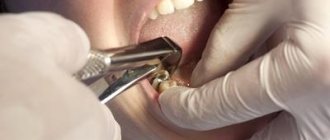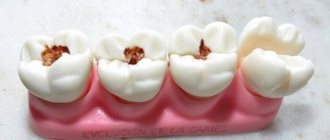A swollen cheek, an asymmetrical, distorted face and, of course, an expression of severe pain in the eyes - this is what gumboil, scientifically called periostitis, or inflammation of the periosteum, looks like. It happens that a person goes to the clinic precisely when he is already beginning to be frightened by such a reflection in the mirror and/or tormented by acute pain - but dentists warn that all this is the result of neglected, previously untreated caries. That's why gumboil is considered a "lazy patient's disease" - it can be avoided if you start treating carious lesions at an early stage.
Read more about: what is flux
In detail, gumboil is a disease accompanied by inflammation of the dental periosteum. The development of flux begins from the internal dental tissues or gum pockets when food debris gets into them. As a result, serious suppuration begins, which grows to the periosteum, and the soft gingival tissue on the inside of the cheek begins to swell.
Flux is accompanied by severe pain with a certain frequency. If the symptoms of flux are not diagnosed in time and you do not visit the dentist, the infection can reach the brain. The most common symptoms of gum gum disease are presented below.
Consequences of untreated flux:
- abscess (abscess) - the formation of a purulent sac;
- phlegmon - an extensive inflammatory process after the rupture of an abscess;
- osteomyelitis of the jaw - inflammation of the tissues of the jaw bone;
- inflammation of the sinuses of the skull - the sphenoid, maxillary and frontal sinuses are involved in the pathological process. Sometimes the infection penetrates into the brain tissue.
Important: specialists from the “Smile” clinic network recommend starting treatment as early as possible. The faster the inflammation is stopped, the less effort will be required to eliminate the problem and restore the patient’s health.
Symptoms of flux on the gums
Symptoms of flux on the gums are most often characterized by:
- The appearance of swelling on the gum tissue;
- Significant increase in body temperature;
- The appearance of acute pain in the gum area and the adjacent tooth;
- Shooting pain in temple, ear, neck;
- There is pain when chewing food;
- Enlarged lymph nodes;
- One of the most common and well-known symptoms of gum gum development is facial asymmetry.
What happens if periostitis is not treated?
It's simple. An increasing amount of pus will cause further development of swelling and puffiness of the face. Further, the lymph nodes located in the neck may become larger. Inflammation will also cause fever and pain.
A very dangerous complication of flux is phlegmon. This is a breakthrough of the “bag” in which the pus is located, and the free spreading of the contents over the muscles and tissues of the cheek, neck, etc.
Jaw osteomyelitis is another possible complication of untreated gumboil: it is an inflammation of the jaw bones (usually this occurs in the lower jaw).
In other words, it is better not to allow serious consequences, but to seek qualified medical help as soon as possible.
Causes of flux on the gums
Flux on the gums can develop for three reasons:
The first reason for the development of gumboil on the gums is poor-quality treatment of periodontitis or pulpitis in a dental clinic. Sometimes there are cases when a dentist performs a root canal filling procedure inappropriately. That is, the top of the tooth root remains not completely sealed. This treatment creates favorable conditions for the development of the inflammatory process in this area. Pathogenic microorganisms begin to actively multiply and extend beyond the apex of the tooth root, then spreading to neighboring tissues;
The second reason for the development of gumboil is the untimely referral of a patient with pulpitis or caries to dentistry. Many people instead eliminate pain in the gums and teeth by taking painkillers, which is why the infection often gets into the carious cavity - into the pulp, which leads to the development of an acute inflammatory process, and the patient suffers from shooting pains in the tooth area. But if he does not see a doctor at this stage, then the infection goes beyond the pulp. As a result, inflammation develops in the tissues that surround the tooth root with the presence of purulent accumulations;
Exacerbation of symptoms of periodontitis. Due to the destruction of the gingival tissue connecting the tooth root and gum, gum pockets are formed. This pocket often contains hardened subgingival plaque - stone. In addition, the pocket contains pus and granulations. Due to the depth of the pocket, the outflow of pus from it is quite difficult. As a result, a purulent abscess forms in the gum tissue, which is the cause of gumboil .
What causes periostitis?
To understand why the tissues of the periosteum become inflamed, you need to understand how carious tooth damage develops in general if it is not treated and is not prevented in any way.
First, a section of enamel and dentin are destroyed. Then the infection descends lower - into the root canals of the tooth. At this stage, a person usually experiences toothache - since a living nerve is affected, which, under the influence of infection, becomes inflamed and begins to gradually “die”, that is, actually rot. If the patient does not go to the doctor even then, but decides to give himself a test of masculinity and endures the pain (or “seizes” it with handfuls of painkillers and muffles it with rinses), then the nerve will rot and the pain will recede. However, this, of course, does not mean a cure. Because further along the open root canals, food debris can get into the tooth cavity or into the gum pocket - and suppuration will begin there. There is not always a way out for this pus, but a way out is needed - and it is found: the pus passes into the soft tissue of the periosteum. That is, a bag filled with pus forms in the periosteum. In this case, as a rule, the patient feels pain, which can radiate to the ear, neck or even eyelid (if periostitis is on the upper jaw). And on the gum of the tooth that caused the inflammation, a seal can form and then pain can be felt not only when biting on the diseased tooth, but also on neighboring teeth.
However, caries is a common, but not the only reason for the appearance of gumboil. Sometimes suppuration occurs due to improper tooth extraction - and such patients come to VivaDent to treat the consequences of unsuccessful surgical interventions in other clinics.
Although it also happens that even mechanical trauma to the gums and jaw tissue can cause gumboil - for example, in athletes who have received a blow to the jaw.
Also among the diseases that can cause the appearance of gumboil are pulpitis, periodontitis and periodontitis.
And sometimes swelling of the cheek is caused by improper eruption of “eights” - that is, wisdom teeth.
Diagnosis of the disease
If you are almost sure that you have flux, then you need to perform the following diagnostic procedures:
- It is necessary to carefully and efficiently examine the oral cavity for the presence and detection of inflammation;
- At the dentist's appointment, palpation and percussion (tapping) of the tooth, which is the source of inflammation, is performed;
- It is necessary to take an x-ray of the mouth to determine the current condition of the tooth causing the gumboil, surrounding teeth, and jaw.
Is it possible to pierce flux with a needle at home?
Many self-medication methods are extreme, but this does not make them more effective. Some patients are confident that they can pierce the flux themselves with a regular needle, even at home.
After this, they use various rinses and lotions. However, positive results after such manipulations are extremely rare.
Under no circumstances should you violate the integrity of the gums or skin on your own. Such operations can have extremely negative consequences:
- worsening of the inflammatory process;
- an increase in the amount of pus in the abscess;
- pus can penetrate into spongy and soft tissues;
- may develop as a complication ;
- Cellulitis without proper treatment develops into sepsis.
How to quickly remove swelling from dental flux
Flux cannot be called a disease that comes from outside.
Only an experienced specialist can open the flux, since this manipulation is classified as surgical.
On the Internet you can read many reviews from people who opened the flux themselves using a needle. Even if such an “operation” was successful, it still remains extremely dangerous, so you need to consult a doctor instead of conducting experiments on your own health.
Methods for treating gumboil
The specialist, depending on the results of the examination, can make the following decisions regarding the treatment of flux :
- Save the tooth by making an incision into the abscess and cleaning out the pus from it;
- Remove the diseased tooth by following the procedures described above.
Treatment of gumboil while preserving the tooth
First of all, the dentist removes the nerve from the diseased tooth, all dental tissue affected by caries is drilled out with a bur, and the root canals are processed.
After the autopsy, the dentist, if necessary, prescribes the patient to take certain antibiotics. In addition, mouth rinsing procedures are prescribed, as well as special oral baths, which the patient carries out independently at home.
How can a patient harm himself if he has gumboil?
It is worth warning that in principle there are no home methods for completely curing gumboil - there are only some rinsing recipes (in particular, a decoction of oak bark, sage, lemon balm, etc.) that can slightly dampen the inflammation in the outer part of the gums. Rinses do not penetrate into the tooth cavity and do not wash out pus, so they are only suitable to relieve discomfort and slow down the process a little before a visit to the dentist and qualified manipulations.
In addition, until the inflammation is completely relieved, you should not eat hot food, drink hot tea and coffee, press your cheek to a warm radiator, etc. - heat provokes a more rapid proliferation of bacteria, which remain in the area cleaned of suppuration. In addition, the popular myth about bandages and compresses for flux should be debunked - they are not recommended and are even dangerous! The character in the film “Operation Y...”, who came to take the exam wearing a tight and warm bandage on his cheek, in real life could harm the real flux - since excessive pressure can cause a breakthrough of pus into the sinuses or phlegmon.
Also, after opening an abscess or opening the canals, the patient should not independently select antibiotics and start taking them, as it is easy to make a mistake.
Prevention
To avoid symptoms of flux development, the following recommendations must be followed:
- Maintain daily oral hygiene;
- Diagnose foci of the disease in a timely manner;
- Development and strengthening of immunity;
- Taking medications must be strictly dosed;
If you notice swelling in the gum tissue, you should not postpone your visit to the “Health” dentistry in Mytishchi. A timely visit to a highly qualified dental specialist will help not only prevent the development of gumboil and other unpleasant diseases, but also prevent the symptoms and causes of flux on the gums, and treat it , saving teeth from removal.
Treatment algorithm
The treatment protocol for periostitis involves a combination of surgical, medicinal and physiotherapeutic methods:
- taking (or a course of injections) antibiotics to destroy pathogenic microflora;
- opening the purulent sac (using local anesthesia), and in difficult cases, installing temporary drainage to drain the pus;
- eliminating the cause that caused the formation of flux: treating a tooth or extracting it if therapeutic measures are inappropriate, cleaning periodontal pockets;
- treating the wound with an antiseptic (gel, rinsing) until it is completely healed;
- course of physiotherapeutic procedures.
Expert advice: after opening a purulent sac, you should not apply warm compresses or take antibiotics that have not been approved by the doctor. If pain continues more than 8 hours after surgery, you should contact the clinic immediately.
Forecast
If the patient strictly adheres to all recommendations and carefully monitors hygiene, then there is no need to fear relapses.
If treatment was started already in the acute stage of flux or interrupted in the middle, then the prognosis becomes less pleasant. Flux can become chronic, which increases the risk of re-development several times. If the patient does not seek qualified help on time, then the flux can even cause blood poisoning, which leads to death.
It is very important to use only proven treatment methods and consult with experienced specialists, since some consequences of self-medication can be even more unpleasant than the disease itself.
Chronic flux
Periostitis of the jaw can be acute or chronic. In the first case, the disease progresses very quickly and immediately makes itself felt, but as for the chronic form, the pathological process can develop over many months, while the person experiences virtually no discomfort, and there is also no pain or symptoms preceding the onset of the disease.
Chronic periostitis in most cases is localized on the lower jaw and is divided into three types:
- Simple – occurs in the initial stages of the disease.
- Ossifying - is formed during prolonged irritation of the periosteum, which because of this is in an inflamed state.
- Fibrous - characterized by the formation of thickening in the periosteum area.
Treatment of chronic flux, just like acute flux, should begin, first of all, with eliminating the factor that triggered the pathological process. That is, it is necessary to treat caries, clean the canals, or completely remove the causative tooth.











